Mark Sisson's Blog, page 148
March 15, 2018
5 Easy Lunches From Primal Leftovers
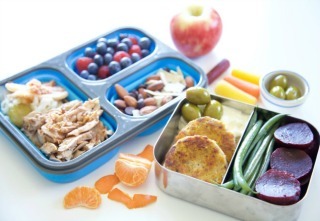 Most days of the week, Mark’s Big-Ass Salad is the best lunch for his day. But not everyone would say the same, and that works, too. On days when you crave something different for lunch, the most convenient and money-saving solution is packing up leftovers from the night before. Pack as much or as little as you want, throw together some tasty Primal sides, and you’re good to go. To offer a little inspiration toward your midday meal prep, here are five dinners that make excellent lunches the next day. Be sure to share yours in the comment board as well!
Most days of the week, Mark’s Big-Ass Salad is the best lunch for his day. But not everyone would say the same, and that works, too. On days when you crave something different for lunch, the most convenient and money-saving solution is packing up leftovers from the night before. Pack as much or as little as you want, throw together some tasty Primal sides, and you’re good to go. To offer a little inspiration toward your midday meal prep, here are five dinners that make excellent lunches the next day. Be sure to share yours in the comment board as well!
Pulled Pork
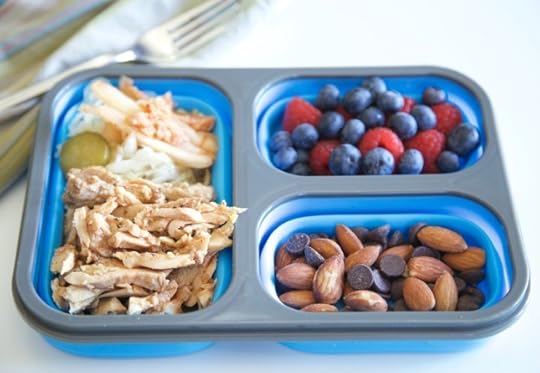
There are many ways to slow-cook pork shoulder to tender, succulent perfection. Pack the pork up with one of these delicious lunch box combinations:
Pulled pork + Fermented veggies (pickles or kimchi) + Fresh Berries + Almonds and unsweetened 100% cacao chips
Pulled pork + Primal Cornbread + Coleslaw
Pulled pork + Hard boiled eggs + Macadamia Balls
Chipotle Lime Mayo Chicken Salad

Here’s an easy lunch: Leftover chicken + Primal Kitchen® Chipotle Lime Mayo = instantly flavorful, spicy, chicken salad
Pack up your chipotle chicken salad with:
Bell pepper strips + Parmigiano-Reggiano Crisps + Kiwi and Berries
Nuts and Olives + Steamed Broccoli with olive oil
Apple slices + Nut butter
Hot or Cold Soup

Every time you make soup, like this Aromatic Beef Soup with Mushrooms and Chard or a simple 10-Minute Seaweed Soup (pictured), ladle a single serving into a resealable plastic bag and freeze it. Pop that frozen bag into your lunchbox, and it will mostly be defrosted by lunch. Yes, a hot bowl of soup does require a microwave at the office. Or, pack up a refreshing cold soup.
Salmon Burgers

This recipe for Cajun salmon burgers has simple instructions for making the perfect salmon burger. Add the Cajun spices, or not, and definitely double the recipe because these salmon burgers are delicious served hot or cold. Either way, make sure to pack a small container of Primal Kitchen mayo for dipping.
Need sides for you salmon burger lunch? Try:
Roasted beets + Green beans + Olives
Pumpkin Seeds + Unsweetened Coconut
Keto Muffin
Larb Lettuce Wraps
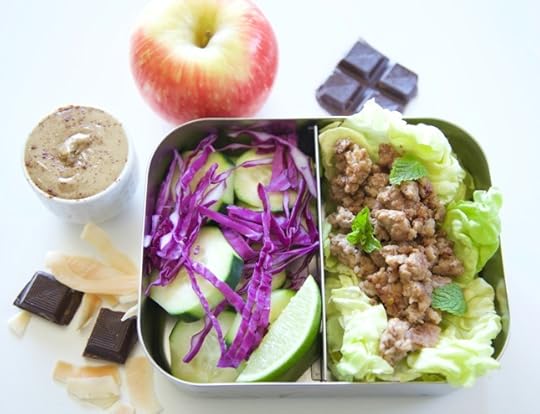
Larb is a quick dinner made from ground meat. Double this recipe, and you’ll also have larb lettuce wraps for lunch. Mint, cilantro, lime and hot sauce all add more flavor. Pack larb lettuce wraps up with:
Cucumber and Shredded Cabbage + Nut Butter with Cinnamon + Apple + Dark Chocolate
Hard boiled egg + Clementine Orange
Fresh berries + Fat Bombs
As mentioned, pack enough to fit your personal appetite and tailor sides to complement your Primal or keto goals. Thanks for stopping by today, and share your feedback and favorites with the group. Be well.

The post 5 Easy Lunches From Primal Leftovers appeared first on Mark's Daily Apple.



Primal Starter: Reframing Your Definition of Affluence
 “Gratitude, with a capital G. The word should resonate as holy (which has the same root as healthy, and means whole), for without it, boredom prevails. With it, you acknowledge and appreciate life’s gifts. This embodiment extends beyond your attitude to become an actual personality trait, a stress management took, an an overall way of life. You live in gratitude because you are here today—appreciative of the lessons and journey of your past, however imperfect—for no other particular reason or caveat. And you remain in gratitude through the daily struggles that give meaning and richness to your life.
“Gratitude, with a capital G. The word should resonate as holy (which has the same root as healthy, and means whole), for without it, boredom prevails. With it, you acknowledge and appreciate life’s gifts. This embodiment extends beyond your attitude to become an actual personality trait, a stress management took, an an overall way of life. You live in gratitude because you are here today—appreciative of the lessons and journey of your past, however imperfect—for no other particular reason or caveat. And you remain in gratitude through the daily struggles that give meaning and richness to your life.
Our ancestors devised animism and deities to thank for the bounties in nature. More recently in our history, tribal societies such as the Native Americans and the !Kung Bushmen of southern Africa thank the animal’s spirit for providing sustenance after it has been killed. If daily prayer or weekly services have a place in your life, you may be familiar with similar themes. But don’t overlook other modest ways to show gratitude in your day-to-day life. Giving yourself the luxury of a warm bath, making a phone call to Grandma, or presenting a home-cooked meal to your family all count, too, if your intention is in the right place.
When you practice an attitude of gratitude, you appreciate what you have, not envy what you lack. It means you’re a good steward. You nourish and exercise your body and mind, cherish and respect your spouse, love your dog, keep your home clean and orderly, encourage your children. If you water your garden, you’ll watch it grow….
But don’t take my word for it. Let’s look at the science: University of California, Davis professor Robert Emmons, editor-in-chief of the Journal of Positive Psychology and author of Thanks!: How Practicing Gratitude Can Make You Happier, believes that living in gratitude is the single quickest and most efficient pathway to becoming happier. Yes, Emmons and other leaders in the burgeoning field of positive psychology can actually quantify this stuff, asserting that while familial genetics plays a large role in longevity, researchers have amassed significant data suggesting that up to 75 percent of longevity is related to psychological and behavioral factors. Emmons notes that chronically angry, depressed, or pessimistic people have long been observed to have an increased disease risk and shorter life spans. However, those who kept a simple ‘gratitude journal’ for three weeks or longer reported better sleep, increased energy, heightened creativity, enthusiasm, determination, and optimism…and an increased desire for exercise. Now that’s something to be grateful for!”
From The Primal Connection, pgs. 68-69
The post Primal Starter: Reframing Your Definition of Affluence appeared first on Mark's Daily Apple.



March 14, 2018
Is the Autoimmune Protocol Right For You?
 If you think going Primal is restrictive, the autoimmune protocol is downright draconian. But this is by design. The entire point of an autoimmune Primal/paleo protocol is to eliminate all the foods with the potential to trigger any allergenic, autoimmune, or inflammatory responses. That leaves out a lot of delicious foods, many of your favorites—but it can be a powerful way to assess your sensitivities, target the root causes of mysterious health problems, and illuminate a path forward. It gets you back to square one. A fresh start, a wiped slate.
If you think going Primal is restrictive, the autoimmune protocol is downright draconian. But this is by design. The entire point of an autoimmune Primal/paleo protocol is to eliminate all the foods with the potential to trigger any allergenic, autoimmune, or inflammatory responses. That leaves out a lot of delicious foods, many of your favorites—but it can be a powerful way to assess your sensitivities, target the root causes of mysterious health problems, and illuminate a path forward. It gets you back to square one. A fresh start, a wiped slate.
Okay, maybe not totally clean. This is biology we’re talking about. There are no clean slates. Vestiges of past consumption, behaviors, and decisions always remain and affect us into the future. Unless you clone yourself and rear the baby, you’ll always be left wondering “what might have been had I stayed pure…” But this protocol is about the cleanest you’re going to get.
After the elimination phase, after symptoms have improved, you enter the maintenance phase. You marinate in the diet. Allow it to seep into your pores, do its magic.
When everything has stabilized, you can try reintroducing foods. Go slowly. Do one at a time. A little nibble here, a teaspoon there. Allow two or three days before trying the next food. Note any symptoms.
What Do You Eliminate?
Here’s a complete list:
Grains
Legumes, such as beans, lentils and peanuts
Processed foods
Seed oils, such as vegetable and canola oil
Dairy products
Refined sugars
Eggs
Nuts and seeds
Herbs from seeds, like coriander, cumin and nutmeg
Coffee
Chocolate
Dried fruits
Food additives, like gums and emulsifiers
Nightshade vegetables, such as eggplant, potatoes, tomatoes, peppers and okra.
Spices made from nightshades, like chili powder, paprika, cayenne, chipotle, red pepper.
Alternative sweeteners, like stevia, xylitol and mannitol
Alcohol
NSAIDs (not a food, but bad for your gut lining)
Much of the autoimmune protocol will sound familiar to you. Avoiding grains, legumes, seed oils, sugar, and processed stuff in general is easy. You already do that.
But then you start eliminating some other foods you assumed were innocuous, like, for example, dried fruits.
Dried fruits seems extreme—they’re fruits, after all—but who really needs to eat a bunch of apricots, prunes, and dates? They’re so high in sugar and add up real quick. No problem there.
Emulsifiers and gums? Sure, who needs ‘em. I can emulsify and thicken just fine with a trusty egg yolk.
Wait, what? No eggs? How am I going to do breakfast? I guess I’ll have to eat some paleo granola…
Oh, nuts and seeds are out too. Never mind.
That’s cool. I’ll just pour a little extra cream in my coffee.
Shoot. Dairy’s out, too. Black coffee it is!
Why are you making that face? Don’t even—I can’t have coffee, can I?
Hey, that’s fine. I’ve been meaning to get into tea. A big steaming mug of jasmine green tea will be just fine. I might even nibble on a square of dark chocolate while I’m at it. Antioxidant explosion, here I come!
Wait. Damnit. Chocolate is a legume, and legumes are out. No chocolate either.
Like I said, this isn’t easy. After eliminating all the potentially allergenic foods, you’re left with the basics:
Meat, fish, and poultry.
Fruits and vegetables, except for the nightshades.
Coconut.
Fruit oils (avocado, olive, coconut, palm) and animal fats.
Herbs.
Bone broth (or gelatin/collagen).
Tea.
Vinegar.
You’re removing foods with the potential to irritate the gut and increase inflammation. You’re focusing on “safe” foods that allow the gut to heal (and foods that actively increase gut health).
Why Is This Important?
Some leading autoimmune researchers have proposed that the primary cause of autoimmune pathogenesis is impaired intestinal permeability—or leaky gut. A leaky gut allows proteins, toxins, and other compounds into circulation that aren’t supposed to be there. The body mounts an immune response to the invaders. If the gut stays open, the inflammatory response stays elevated. And if the immune system gets its signals crossed and starts targeting your own tissues that resemble the invading particles, you have the beginnings of an autoimmune disease.
Who’s It For?
1. Folks with autoimmune diseases.
Until recently, the autoimmune protocol was based on biological plausibility, educated conjecture, and a convincing stream of anecdata. It hadn’t been demonstrated in a legitimate study. It did seem to work for many of the people trying it, but it hadn’t been demonstrated in a legitimate study. That changed in 2017 when a study found the autoimmune protocol to be effective against inflammatory bowel disease. 15 patients with either Crohn’s disease or ulcerative colitis were enrolled in the study. On average, the subjects had been ealing with their disease for 19 years. These were IBD lifers.
They spent 6 weeks phasing out all the foods, using Sarah Ballantyne’s great book on the autoimmune protocol as a guide. Experienced Primal eaters could probably phase out the foods more quickly, though the 6 week phase out might be an important part of the total effect.
They spent 5 weeks maintaining the protocol once everything was eliminated and symptoms had stabilized.
11 of 15 patients had total remission. They’d spent an average of 19 years having to map out the nearest toilets whenever they left the house, and all of a sudden they were basically normal. That’s huge. That’s better than any IBD drug.
There are limitations here. 15 subjects is quite low; I’d like to see ten times that many. There was no control group; this wasn’t a randomized trial (which the authors acknowledge). But it’s quite impressive and bodes well for other autoimmune conditions.
Although this was the only study to examine the entire autoimmune protocol, we know that specific foods play roles in certain autoimmune conditions. Gluten-containing grains are a major, perhaps the major offender, since gluten has the tendency to wrench open the tight junctions in our guts (leaky gut) and allow passage of food particles and endotoxins into our bodies where they can trigger inflammatory and autoimmune processes. Gluten-free diets have been shown to help with:
Autoimmune hepatitis.
Type 1 diabetes (an autoimmune disease).
Rheumatoid arthritis.
Multiple sclerosis.
Coffee has a perplexing relationship to autoimmune disease. For instance, it’s well-known to be protective against type 2 diabetes, but appears to increase the risk of autoimmune type 1 diabetes.
Legumes, other grains, seeds, and nuts are all potential triggers of further gut irritation. While I’ve softened my general stance on some of these foods in recent years, they remain problematic for people with avowed food sensitivities or autoimmune conditions.
2. Folks who suspect they have sensitivities to foods.
We eat a lot of food throughout the course of a given day or week. It’s hard to keep track. It’s impossible to keep track, unless you, well, keep track in an explicit manner. And many of us experience odd symptoms we suspect are linked to food—rashes, stuffy noses, itchiness, grogginess—but without the written logs we flail around in the dark. Maybe we’re lucky for awhile. Maybe we nix the right food. But if we don’t know what we’re doing, we’re just as likely to eat the wrong thing, or eliminate too many things.
The AIP lights our way. It provides a baseline. Eat the foods you know are non-reactive and avoid all the foods that have the potential to cause problems. Once the symptoms improve or go away, maintain the protocol for several weeks, then begin adding foods back in one at a time. When the symptoms return, match it with the food you’ve just reintroduced.
3. Curious folks.
As a reader of MDA, you are probably a nutrition geek. You enjoy needing out on dietary minutiae. You like experimenting on yourself. You’re curious about how certain foods interact with your health, and an autoimmune protocol can reveal that. It’s just good information to have, mostly.
Who Isn’t It For?
Most people. Most people don’t have an autoimmune disease and don’t need to go on an autoimmune protocol.
If you’re happy with your diet and how you respond to foods, don’t bother. It will only create unnecessary headaches. Recall that extended dairy restriction may even induce lactose intolerance. Some claim that you were always sensitive to dairy, that your body had learned to deaden you to the subjective experience of the damage being done. I say dairy is a healthy food if you can tolerate it. Inducing lactose intolerance isn’t in anyone’s best interest, if they can avoid it.
If you’re the type to obsess over food, and you know your sensitivity is a psychological hang-up rather than a true autoimmune response, skip the protocol. It will only feed your obsession and leave you unable to think about anything else but your diet for the duration.
This isn’t for life (probably).
You can certainly eat well and enjoy what you eat on an autoimmune protocol. But the point is not to stay on the diet indefinitely. It’s to wield it as an effective tool, a broad brush that isolates all the likely suspects for questioning. Then you use the scalpel of inquiry to determine which foods—if any—are truly problematic. If you have to keep milk or peanuts or chocolate out forever, so be it. But make sure that’s what your n=1 data is actually saying.
The protocol isn’t a magic bullet. It isn’t a cure. Many other factors contribute to impaired gut health, chronic inflammation, and likely therefore autoimmunity, like poor sleep, stress, lack of exercise, poor relationships, nature deprivation, sun deprivation, and circadian dysregulation. You need to address those too. But diet is a big one, and it’s an obvious target with an established protocol.
Have you ever tried an autoimmune protocol? Are you going to try it after reading today’s post? I’d love to hear your experiences.
The post Is the Autoimmune Protocol Right For You? appeared first on Mark's Daily Apple.



Primal Starter: 5 Exercises To Do At Work Today
 I’ve been in meetings with the woman who did lunges in the corner while the rest of us sat around a conference table. I’ve watched a guy lift a kettlebell he kept under his desk every time he took a phone call. There’s nothing wrong with any of that. But not everyone works in a space where that would realistically fly. That said, frequent movement is one of the best things you can do for yourself. It’s the base of the Primal Blueprint Fitness Pyramid for good reason. So, if you’re stuck in cubicle land all day or can only get away for a few minutes at a time, what are some more “covert” ways to fit in some movement in your work day?
I’ve been in meetings with the woman who did lunges in the corner while the rest of us sat around a conference table. I’ve watched a guy lift a kettlebell he kept under his desk every time he took a phone call. There’s nothing wrong with any of that. But not everyone works in a space where that would realistically fly. That said, frequent movement is one of the best things you can do for yourself. It’s the base of the Primal Blueprint Fitness Pyramid for good reason. So, if you’re stuck in cubicle land all day or can only get away for a few minutes at a time, what are some more “covert” ways to fit in some movement in your work day?
Loaded Stair Ascension
The stairwell (if you have access to one) can become an office gym for simple walking or sprints, but add a little imagination for some extra benefit.
Try walking the stairs while carrying something heavy, like a box of printer paper. If your office has gone exclusively electronic, maybe it’s a box of tablets or something. Or a willing co-worker (or, for a tougher workout, a non-willing co-worker).
Switch it up: Skip a step or two as you climb, turning a simple loaded stair walk into a walking stair lunge. Change how you hold the object, too – overhead with two hands, overhead with one hand, in the front rack position, on either shoulder, out in front of you.
Stair Jumps
Plyometric exercises like box jumps are great, but jumping down from the box as many times as you jump onto it can do a number on your joints if you’re not careful. By using the stairs, you’re never jumping down. You’re always going up. That makes it harder (for your muscles, stamina, etc.) but easier (on your joints and connective tissues).
Switch it up: Try single leg jump, single leg landing; single leg jump, double leg landing.
Faux Sitting
If you’re stuck at a desk for longer stretches of time, you still have options. Engage your glutes and raise yourself up in your chair by about an inch, so you’re just hovering over the chair in a squat position. Hold that squat for as long as you can. Passers-by will just assume you’re furrowing your brow because you’re working so hard. They’ll never suspect that you’re exercising.
Switch it up: Do it single-legged. Lightly, slowly, almost imperceptibly bounce up and down.
Isometric Contractions
Even though it sounds like it wouldn’t work, voluntarily contracting your muscles as hard as you can and holding it can increase strength and size. In a 2013 study, researchers asked trainees to do the following training regimen: hold your elbow at a 90 degree angle and flex your biceps and triceps as hard as you can for four seconds followed by four seconds of rest; do this for 5 sets of 10 contractions, three days a week for 12 weeks. After 12 weeks, trainees had increased extension and flexion strength and added 4% to the size of their biceps and triceps. You don’t have to make this your sole workout routine, but it wouldn’t hurt to do a few contractions during downtime just to keep your muscles primed.
Switch it up: Try doing the same with your legs.
Stand Up
Yep: just stand up. Stand up from your chair and sit back down. Do it a couple more times. Do it again in two minutes. Stand up at least once a minute. There are many ways to do it. The important thing is that you work against gravity on a regular basis. It’s not hard, and you don’t have any real excuses not to. So stand up. Often. It’s probably more effective to do this throughout the day, rather than do a single set of 50 stand ups.
Switch it up: Stand up with one leg, sort of a mini one legged box squat.
Bonus: Resistance Band Shoulder Abductions
This one is obviously an exercise that might elicit attention from those around you, but the results of a recent study were so compelling that I’d say it’s more than worth the gawking of coworkers. Researchers took two groups of office workers with frequent neck and shoulder pain and had one group do resistance band shoulder abductions (video here) for two minutes a day for 10 weeks. The control group merely got health advice for fifteen minutes a day over the same period. In the exercise group, complaints of neck and shoulder pain dropped by 40%, while strength increased by 6%. No such effects were seen in the control group.
Switch it up: No band? Do isometric abduction contractions against the desk using the same arm/shoulder position.
The post Primal Starter: 5 Exercises To Do At Work Today appeared first on Mark's Daily Apple.



March 13, 2018
Enjoy a Collagen Peptides Green Smoothie—And Win a Vitamix!
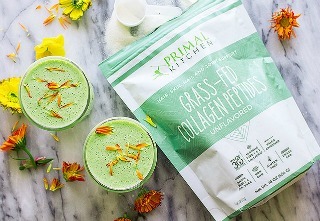 We’re serving up an early midweek recipe that will have you thinking spring—or St. Patty’s Day—along with a giveaway you won’t want to miss….
We’re serving up an early midweek recipe that will have you thinking spring—or St. Patty’s Day—along with a giveaway you won’t want to miss….
Fresh basil gives this refreshingly tart and tropical smoothie just a hint of herbal flavor. Boosted by Primal Kitchen® Collagen Peptides, this green smoothie offers ingredients that support healthy hair, skin and nails and connective tissue.
Ingredients
2 scoops Primal Kitchen Collagen Peptides
¾ cup plain, full-fat kefir (or your favorite non-dairy milk) (180 ml)
½ cup (or a small handful) baby spinach leaves (5 grams)
½ cup fresh, chopped pineapple or frozen pineapple (100 grams)
6 basil leaves
2 ice cubes
Instructions
In a blender, combine Primal Kitchen Collagen Peptides, kefir, spinach, pineapple, basil and ice.
Blend until smooth and frothy.
Now for the Giveaway…
Enter HERE for a chance to get lucky with a brand-spanking-new Vitamix Blender, plus $200 in Primal Kitchen Collagen Fuel and Primal Kitchen Collagen Peptides. Winner will be announced 3/19!
And regardless of whether or not you take home the grand prize, everyone who enters will receive a code for 20% off our whole line of Collagen Fuel and Collagen Peptides at the conclusion of the giveaway!
Enter today—and while you’re at it scroll down the entry page to check out five other delicious green smoothie ideas to try. Be sure to share your favorite!
The post Enjoy a Collagen Peptides Green Smoothie—And Win a Vitamix! appeared first on Mark's Daily Apple.



March 12, 2018
Dear Mark: Folate Follow-up
 For today’s edition of Dear Mark, I’m answering five questions taken from last week’s folate post comment board. Does folic acid increase cancer risk? It’s an open question, but I think we have a pretty good idea of where the research points. Next, what other nutrients can help people with MTHFR mutations? Is there anything else someone with a deleterious variant should focus on eating? Third, is folate good enough, or should you look specifically for 5-methyltetrahydrofolate? Fourth, how do I know if I have a MTHFR variant that increases the need for folate? And finally, what specific form of folate am I using in Master Formula?
For today’s edition of Dear Mark, I’m answering five questions taken from last week’s folate post comment board. Does folic acid increase cancer risk? It’s an open question, but I think we have a pretty good idea of where the research points. Next, what other nutrients can help people with MTHFR mutations? Is there anything else someone with a deleterious variant should focus on eating? Third, is folate good enough, or should you look specifically for 5-methyltetrahydrofolate? Fourth, how do I know if I have a MTHFR variant that increases the need for folate? And finally, what specific form of folate am I using in Master Formula?
Let’s go:
First, Terje asked:
Hi Mark. Would you care to also comment on potential increase cancer risks connected to folic acid? Particularly breast and prostate.
This is a common concern, mostly because folate has a strange relationship with cancer.
On the one hand, folate is critical for cell division, and, as you know, cancer is highly dependent on rapid cell division. Cancer cells consume a ton of folate. They demand it, so much that a class of anti-cancer drugs known as “anti-folates” block folate metabolism and arrest cancer cell proliferation.
On the other hand, folate is also critical for maintaining the integrity of our DNA. Folate deficiency can lead to DNA strand breaks (double helix is severed, must be repaired lest DNA rearrangement occur), increase the frequency of mutations, and cause cancer.
Overall, scientists haven’t found any strong links between folic acid supplementation and prostate or breast cancer. A 2013 meta-analysis of controlled human trials found no connections between supplementation and cancers of any kind, except for melanoma—for which folic acid was protective.
Those were results for synthetic folic acid. I’d have to imagine the links between folate and cancer are even more positive.
Meg made a great point:
Don’t forget the importance of choline to conserve folate stores. Some MTHFR mutants end up on megadoses of methylfolate and/or folinic acid, but the need for this would go down if they remembered to take phosphatydl choline, or to increase their consumption of foods like liver.
Great point. I’ll expand a bit.
If you don’t make/have adequate 5-methyltetrahydrofolate, either because you’re not eating enough of the precursors, you’re an MTHFR mutant (sounds pretty damned cool, actually), or you’re taking the wrong kind of folic acid/folate, choline can step up and perform many of the same tasks folate normally performs. This is a good way of getting around the folate deficiency, but you have to eat enough choline because your requirements will go way up. In one study, Mexican-American men with low folate status due to MTHFR mutations who took 2200 mg of choline per day (around 4x the normal daily dose) reduced DNA damage and improved cellular methylation.
MTHFR mutations might also increase glycine wastage. Since glycine is a crucial yet underappreciated amino acid that plays an important role in joint health, methionine metabolism, and sleep (to name a few functions), you’ll also want to eat more glycine in the form of gelatinous meats, bone broths, or collagen powder.
Creatine is another nutrient to consider. Normally, MTHFR mutations increase homocysteine, since there isn’t enough folate around to methylate it into methionine. Folks with MTHFR mutations who supplemented with creatine lowered their homocysteine levels, perhaps by regenerating tetrahydrofolate.
Susan asked:
I take a B complex, the label just lists folate. So I really should be looking for a B complex that lists 5-methyltetrahydrofolate instead?
Not necessarily. “Folate” is a good sign as well. Some “folates” are food-based folates; those will presumably have a spectrum of folate forms, just like you get in food.
Folic acid will always be listed as folic acid. You’ll know it when you get it.
Liz wrote:
I’ve been taking folic acid without any problems. How should I get checked if it’s the right one for me? If I don’t have MTHFR is it still relevant?
First, you’ll need to do a genetic test. You could ask your doctor to order one for you. They’ll probably deem it “elective,” badger you for taking an interest in your health, and refuse to order the test. You could order a dedicated MTHFR test online, but that wouldn’t be my first choice.
You get the most bang for your buck using a service like 23andMe, which gives you ancestry data and, if you pay a bit more, health data. Even if you order just the ancestry results, you’ll still get full access to the raw data that contains the health info, including MTHFR status. They just won’t do the analysis for you.
Once you have your 23andMe results, log in and download the raw data.
Submit the data to a service like Strategene for full analysis.
Read the Strategene report and look for A1298C and C677T. Those are the two main MTHFR gene variants.
The report will tell you if you have zero variants (two minuses; –) or if you’re homozygous (both father and mother passed it on; ++) or heterozygous (one of your parents passed it on; +-) for each mutation. Each “hit” (marked by a “+”) reduces your ability to make folate and increases your need for 5-methyltetrahydrofolate.
If you don’t have any MTHFR mutations, folic acid is probably safe… but you’re still better off getting your folate through food. And if supplementing, taking actual folate will work just as well and limit any potential side effects from excessive amounts of the synthetic version.
Again, if you have B12 deficiencies, folic acid will work better than “better” forms of folate.
Alex wondered:
Just because I have tried multiple types of methylfolate I was wandering if you are using the amorphous salt version (Thorne) or one of the crystalline versions (like Pamlabs medications or methyl-life)
The folate we use is calcium salt-based. The full name is L-5-Methyltetrahydrofolate calcium.
Thanks for reading, everyone. Take care!

The post Dear Mark: Folate Follow-up appeared first on Mark's Daily Apple.



Primal Starter: Daylight Savings Transition
 I imagine there are a few souls dragging out there today. For some people, sleep is already the hardest area to change because of shift work, young children, etc. Add to this scenario the lost hour that disappears into the ether every March, and the effects can be miserable. Even for the “best” situations, switching the clock (in either direction) leaves a person feeling oddly displaced, like you’re never where you’re supposed to be at any given time. The world is going about its business in the usual routine, but something feels off—and it takes at least a few days to finally settle back into a circadian congruence.
I imagine there are a few souls dragging out there today. For some people, sleep is already the hardest area to change because of shift work, young children, etc. Add to this scenario the lost hour that disappears into the ether every March, and the effects can be miserable. Even for the “best” situations, switching the clock (in either direction) leaves a person feeling oddly displaced, like you’re never where you’re supposed to be at any given time. The world is going about its business in the usual routine, but something feels off—and it takes at least a few days to finally settle back into a circadian congruence.
Switching the clocks is just one of those things that underscore how our modern life inevitably strays from natural rhythms. For all but a small fraction of our evolutionary history, humans have equated natural light with awake and dark with sleep. We are still products of that environment, no matter how many bulbs are burning in our houses at 11:00 at night.
In terms of physiology, there’s a legitimate toll to the whole time change project. The circadian rhythm is a powerful physical phenomenon – right down to the molecular level. Hormonal levels, blood pressure, body temperature, even gene activity are directed by it. Although circadian rhythm is ordered and maintained internally, it’s obviously influenced by the external, namely light and dark cycles.
Particularly with the “spring ahead,” more of us find ourselves genuinely struggling. Companies see a rise in workplace injuries because people are tired. For their part, researchers who have analyzed large surveys have even found evidence that suggests we’re wired to stay on standard time. During non-working days, scientists found, “the timing of sleep…follows the seasonal progression of dawn under standard time, but not under DST.” In fact, their study (which also included observation of 50 individuals) concluded that, overall, humans’ circadian rhythm doesn’t truly adjust to daylight savings time period. (The people most negatively impacted, not surprisingly, were the night owls among the group.)
Messing with our bodies’ natural physiological patterns has, as you might expect, real consequences. A study presented to the Society for Neuroscience showed that mice whose day/night cycles were thrown off exhibited “weight gain, impulsivity, slower thinking, and other physiological and behavioral changes.” (Those of us who have ever been sleep deprived can probably identify with these creatures.) Incidentally, metabolic hormones— including insulin—were affected by the day/night cycle changes.
More than ever this week, work with your entrainment options. Get some early sun, and exercise earlier. Dim lights and forgo electronics three hours before bed or even sooner if you can. Shift your meal schedule or consider fasting, a little recognized tool for jet lag, which is essentially what we’re all dealing with today. And good luck dealing with the kids….
The post Primal Starter: Daylight Savings Transition appeared first on Mark's Daily Apple.



March 11, 2018
Weekend Link Love — Edition 494
 Research of the Week
Research of the WeekSeniors who train improve their immune systems.
Dietary cholesterol helps repair damaged brains.
Everyone knows a love song when they hear it.
Sleep disruptions may predict Alzheimer’s.
New Primal Blueprint Podcasts
 Episode 225: Michelle and Keith Norris
: Host Elle Russ chats with the founders of Paleo f(x).
Episode 225: Michelle and Keith Norris
: Host Elle Russ chats with the founders of Paleo f(x).
Each week, select Mark’s Daily Apple blog posts are prepared as Primal Blueprint Podcasts. Need to catch up on reading, but don’t have the time? Prefer to listen to articles while on the go? Check out the new blog post podcasts below, and subscribe to the Primal Blueprint Podcast here so you never miss an episode.
Interesting Blog Posts
What we pass on isn’t always genetic.
Altitude sickness is no joke. Also: choose your porters wisely.
Media, Schmedia
The 2-month Internet vacation that wasn’t.
Captive orangutans get more curious.
23andMe can now tell you about your breast cancer risk.
Everything Else
Buy 2-for-1 organic kale, meet your soulmate.
The authors of one of the most lauded medical textbooks failed to disclose a huge conflict of interest: millions of dollars from the pharmaceutical and medical device industries.
Silicon Valley’s slipping. The latest hotness isn’t diapered indoor chickens. It’s potty-training them with elimination communication.
I love this kind of thing.
Macron’s urging the French to drink more wine.
Cannabis-infused epsom salts receive a positive review.
Things I’m Up to and Interested In
Questions I have to ask: If keto is such an effective way to improve metabolic health and reduce bodyweight in preparation for bariatric surgery, why not just stick to keto and skip surgery?
Concept I’d never really considered: The technology that most distinguishes us from other species—clothing—is the one whose origins we know the least about.
Petition you should consider signing: “Stop the Harassment of Tim Noakes”
Announcement I’m pleased to, well, announce: We’ve got some new dressings and marinades, including vegan ranch (yes).
Now this is disappointing: Neurogenesis may not exist in humans.
Recipe Corner
It’s hard to believe something called “double chocolate no-bake brownie bites” can be healthy, but there you go.
Two vegetables I never think to make into soup: roasted asparagus and cauliflower.
Time Capsule
One year ago (Mar 11 – Mar 17)
Are Infrared Saunas Beneficial? – Yes.
Sugar’s Day is Done? A Review of Gary Taubes’ Latest Treatise, The Case Against Sugar – I liked it.
Comment of the Week
“Nice job Joe. I would say you are actually 175 lbs. You have at least 5 lbs of beard there.”
– Peter Bidowski, your comment reminds me of a topic I need to tackle: Does beard count as lean mass?

The post Weekend Link Love — Edition 494 appeared first on Mark's Daily Apple.



March 10, 2018
Italian Vinaigrette Steak and Roasted Veggie Salad
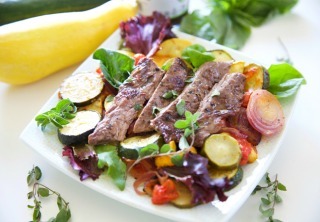 The only seasoning you need for this main course salad is Primal Kitchen® Italian Vinaigrette and Marinade. Citrus and red wine vinegar, plus thyme, basil and oregano, infuse Italian flavor into roasted vegetables and steak. Use the vinaigrette to toss the steak and roasted veg into a green salad, and the meal is done.
The only seasoning you need for this main course salad is Primal Kitchen® Italian Vinaigrette and Marinade. Citrus and red wine vinegar, plus thyme, basil and oregano, infuse Italian flavor into roasted vegetables and steak. Use the vinaigrette to toss the steak and roasted veg into a green salad, and the meal is done.
Italian vinaigrette makes a great marinade for meat, tenderizing with vinegar and lemon, and adding flavor with dried herbs and seasonings. Oil in the vinaigrette keeps meat moist and succulent, but all too often it’s industrial seed oil that you don’t want touching your grass-fed steak. That’s where Primal Kitchen® vinaigrettes are different. Primal Kitchen Italian Vinaigrette and Marinade is made with pure avocado oil and high in monounsaturated fats. Healthful and convenient, this vinaigrette makes it easy to eat right and eat well.
Servings: 4
Time in the Kitchen: 25 minutes, plus 30+ minutes to marinate
Ingredients
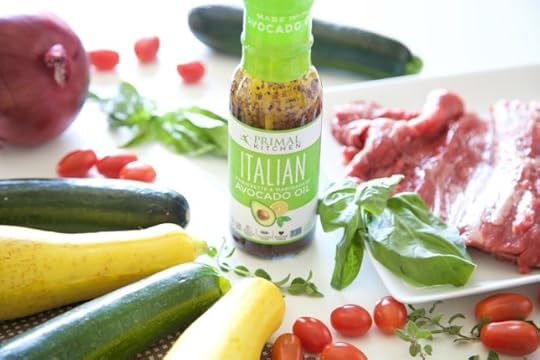
1 pound skirt steak (or other cut of steak, like rib-eye or New York) (450 g)
½ cup plus ¼ cup Primal Kitchen Italian Vinaigrette and Marinade (120 ml plus 60 ml)
3 yellow squash, cut into ½-inch rounds
3 zucchini, cut into ½-inch rounds
1 red onion, thinly sliced
8 ounces cherry tomatoes, halved (230 g)
A few handfuls mixed greens or arugula
Fresh basil and oregano, for garnish
Salt and pepper
Instructions

Preheat oven to 425 ºF/218 ºC.
In a sealable plastic bag (or glass dish), combine steak with ½ cup Primal Kitchen Italian Vinaigrette and Marinade. Toss to coat. Marinate a minimum of 30 minutes, but ideally 2 hours or more.
On a large rimmed sheet pan, toss yellow squash, zucchini, red onion and tomatoes with remaining ¼ cup Italian Vinaigrette and Marinade. Toss well so all the vegetables are lightly coated. Season with salt and pepper. Recipe Tip: For veggies that are lightly browned and crispy around the edges, spread the vegetables out onto two sheet pans instead of just one
Roast vegetables 30 to 35 minutes, stirring once or twice, until done.
Turn broiler to high. Cover a rimmed baking sheet with foil. Remove steak from marinade, shaking off excess liquid. Broil 3 minutes a side, for medium-rare. *The steak can be grilled, instead of broiled.
Slice steak and toss with roasted vegetables, plus torn fresh basil and oregano leaves. Add mixed greens. Dress the salad with Primal Kitchen Italian Vinaigrette and Marinade.
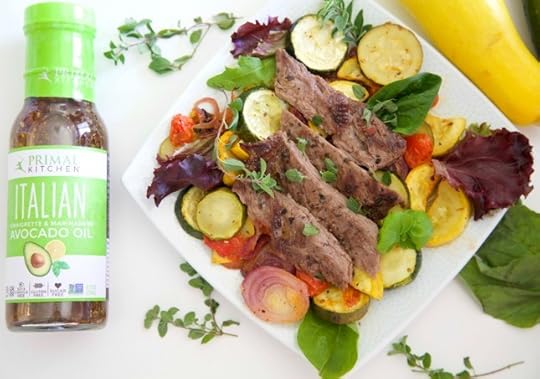
The post Italian Vinaigrette Steak and Roasted Veggie Salad appeared first on Mark's Daily Apple.



March 9, 2018
It’s About Enjoying Life By Being Healthy and Active
It’s Friday, everyone! And that means another Primal Blueprint Real Life Story from a Mark’s Daily Apple reader. If you have your own success story and would like to share it with me and the Mark’s Daily Apple community please contact me here. I’ll continue to publish these each Friday as long as they keep coming in. Thank you for reading!
 My name is Joe I’m 30 years old and have been primal/paleo/Keto for two years now. I have lost over 80 pounds and it has changed my life. I grew up in a small midwestern town Sterling, Illinois. I was an active kid playing every sport there was, Soccer, basketball, football, track and field, wrestling, cross country, and roller hockey. Despite doing all these things I gained weight I was the fat kid from a very young age. I didn’t really understand it because I didn’t feel I was doing anything different than my friends or brother. My brother is 1 year and 6 days younger than me so naturally we participated in many of the same activities and ate similar diets. He was always skin and bones and I was bigger and I just figured that’s how it’s going to be.
My name is Joe I’m 30 years old and have been primal/paleo/Keto for two years now. I have lost over 80 pounds and it has changed my life. I grew up in a small midwestern town Sterling, Illinois. I was an active kid playing every sport there was, Soccer, basketball, football, track and field, wrestling, cross country, and roller hockey. Despite doing all these things I gained weight I was the fat kid from a very young age. I didn’t really understand it because I didn’t feel I was doing anything different than my friends or brother. My brother is 1 year and 6 days younger than me so naturally we participated in many of the same activities and ate similar diets. He was always skin and bones and I was bigger and I just figured that’s how it’s going to be.
By the time I started high school I had narrowed my activities down to just football and working out year round for football. I was 5’11” and around 225 pounds and still gaining weight. I had pretty much accepted the fact that I was a bigger kid and an offensive lineman and I was ok with that. After 4 years of hard work I was named 1st team All Conference on an undefeated football team. I was very proud of this I felt like I had finally been recognized for the effort I put in. But now I’m 5’11” 240 and football is over. That 240 shot to 260 by the time I graduated in May and I was off to college.
I arrived at the University of Iowa in the fall of 2006 at around 265lbs. At that time the dorm cafeteria was basically an all you can eat buffet for every meal. Swipe your card eat as much as you can twice a day and I did (nacho cheese on everything). Oh yeah, and it’s college so lots and lots of beer. By the end of my freshman year I was over 300 pounds. For some sad reason that was always the line in my head where it was time to do something about it. It probably should have been 250 or even 200 but I was young so 300 was the line. I remember when I turned 20 making the comment that I was a quarter of the way dead and my roommate said, “ Dude I’d say you’re more like halfway dead.” He was joking but that got me thinking and I knew I had to lose weight. This is me at 20.
 I started walking/ running and trying to eat a little better which at that time I had no idea what that meant. I lost about 30lbs but the running didn’t last long and I got back up to 290 really quick. I spent about a year not really trying to better myself at all and then I decided to go at it again. I began running again and cut my food to 2 cans of soup a day. Soup was cheap, easy, and I thought hey there’s vegetables. This of course, is no way to go, two cans of processed crap every day but I made it work. My last two years of college I lost 110lbs by running a few days a week and eating basically just soup. I masked my hunger with cigarettes and beer and because I was having the time of my life I felt great.
I started walking/ running and trying to eat a little better which at that time I had no idea what that meant. I lost about 30lbs but the running didn’t last long and I got back up to 290 really quick. I spent about a year not really trying to better myself at all and then I decided to go at it again. I began running again and cut my food to 2 cans of soup a day. Soup was cheap, easy, and I thought hey there’s vegetables. This of course, is no way to go, two cans of processed crap every day but I made it work. My last two years of college I lost 110lbs by running a few days a week and eating basically just soup. I masked my hunger with cigarettes and beer and because I was having the time of my life I felt great.
After college I began a very physically demanding job and started eating whatever I wanted again. I thought losing the weight made me healthy so as long as I wasn’t gaining it back I was good. As you can guess the weight slowly started creeping up. I kept working physical jobs because I thought that was the easiest way to stay active. I ate terrible and never exercised outside of work and the weight returned I was back to 230. I was starting to drive a semi-truck and I knew with less physical demand I would have to watch my weight. I decided I would eat healthy so with conventional wisdom I made my own deli sandwiches every day and ate a bunch of granola bars. I gained 30 pounds in a couple of months so I started hitting the gym hard. An hour on the treadmill and a half hour of weights 4 days a week. I felt the worst I had ever felt in my life bloated and tired all the time. I couldn’t lose any weight either. How could this be? I was eating “better” than I ever had, and working out harder than ever before. I was stumped I thought I was meant to be 260lbs and there was nothing I could do about it.
This is when I discovered Mark’s Daily Apple in February of 2016. I read a few articles and success stories and thought this looks like it makes sense. I bought and read The Primal Blueprint and I was hooked. This lifestyle made more sense than anything else I’d ever tried. I decided to go primal, for the first month I ate only meat and vegetables. I drank nothing but water no soda, beer, or coffee. I worked out less because of low energy levels (low carb flu) and I lost 26lbs that first February. I was like, wow this really works my energy was shooting up. I added some beer and coffee back in and continued to lose weight.
By June I had lost another 26 pounds— that’s 52 pounds in 4 months and I felt better than ever. I was down the rabbit hole of the health world podcasts, message boards, YouTube videos whatever I could get my hands on. I wanted to learn everything I could to become the best version of my self. See when I was younger I didn’t really have a concept of of life. I had the mentality you live and you’re going to die someday. I now realize it’s about really being alive and enjoying life by being healthy and active. After 2 years of being low carb I have lost over 80 lbs. I am 30 years old and in the best shape of my life. I enjoy running and cycling in the summer and kettlebell and body weight training in the winter. Last June I pledged to ride my bike 200 miles for childhood cancer. I raised over $1200 and capped it off with a 96 mile ride from Milwaukee to Chicago for a Dead and Company concert at Wrigley Field.
I still enjoy beer just not as many and I can’t give up pizza but I limit it to a few times a month. I also cook for myself most of the time, which I never did before. I find it incredibly easy to eat and live this way and plan to continue for the rest of my life. I owe all of this to Mark, this website, and this community for the plethora of information I have been led to. Thanks for everything you do and allowing me to share my story. Here’s a picture of me now 5’11 180lbs.
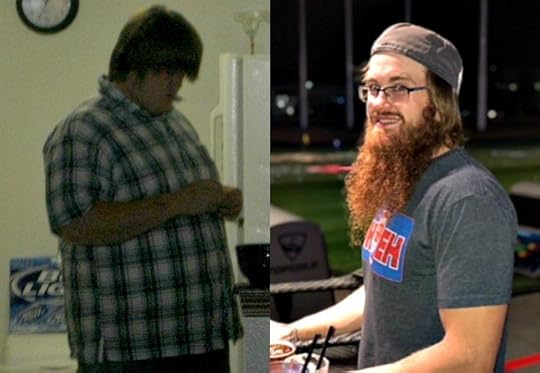
Want to make fat loss easier?
Try the Definitive Guide for Troubleshooting Weight Loss for free here.
The post It’s About Enjoying Life By Being Healthy and Active appeared first on Mark's Daily Apple.



Mark Sisson's Blog
- Mark Sisson's profile
- 199 followers






